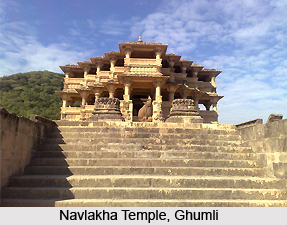 Ghumli is a significant archaeological site located at Barda foothills in Jamnagar District, Gujarat. It is based at a distance of nearly 35 kms away from Porbandar. The village of Ghumli is home to several famous Hindu temples and an ancient stepwell known as `Vikai Vav`, considered to be the largest stepwell in Kathiawar. The most ancient Sun Temple of the state of Gujarat, Navlakha Temple constructed in the Solanki style of architecture is present in Ghumli. The twisted tusks of three elephants are one of the most popular trademarks of this Indian temple. Beside the demolished remains of the Navlakha Temple is situated the `Ghumli Ganesh`, which is a Ganesha temple and regularly visited by the regional inhabitants of the village. Rampol Gate is yet another impressive tourist attraction, and currently the Archaeological Survey of India and Government of Gujarat are making attempts to preserve this historical region.
Ghumli is a significant archaeological site located at Barda foothills in Jamnagar District, Gujarat. It is based at a distance of nearly 35 kms away from Porbandar. The village of Ghumli is home to several famous Hindu temples and an ancient stepwell known as `Vikai Vav`, considered to be the largest stepwell in Kathiawar. The most ancient Sun Temple of the state of Gujarat, Navlakha Temple constructed in the Solanki style of architecture is present in Ghumli. The twisted tusks of three elephants are one of the most popular trademarks of this Indian temple. Beside the demolished remains of the Navlakha Temple is situated the `Ghumli Ganesh`, which is a Ganesha temple and regularly visited by the regional inhabitants of the village. Rampol Gate is yet another impressive tourist attraction, and currently the Archaeological Survey of India and Government of Gujarat are making attempts to preserve this historical region.
History of Ghumli
Also referred to as `Bhumli", Ghumli was once the capital of Gujarat`s Jethwa Dynasty and the village had been founded by Jethwa Sal Kumar during the 7th century. The Jethwa Dynasty proclaimed this area as their second capital in 1220 by Rana Shiyaji. This ruler was said to have adopted the prestigious title of `Rana of Ghumli`, who moved the royal capital from Shrinagar.
Till the year 1313, Ghumli was the official capital, when Rana Bhanji Jethwa lost a war and consequently retreated from Ghumli, to Ranpur. Local legends state that the curse of a Sati called `Son` led to the eventual destruction of Ghumli, who was a lady with whom Rana Bhanji Jethwa had fallen in love with. Ghumli was attacked during 1309 by Jadeja Jam Unaji who had arrived from Sindh, and was captured later in the year 1313. Rana Bhanji Jethwa was defeated by the son of Jadeja Jam Unaji, named Barmaniyaji Jadeja.
It is believed that Goddess Ambaji had appeared in the dream of Barmaniyaji Jadeja that very night and instructed him to establish a temple dedicated to her since She had helped him to conquer Ghumli thereby granting his wish or `Asha`. Thereafter, the Ashapura Mata Temple was erected by Barmaniyaji, in the central portion of Ghumli. The temple is also known as the Temple of Ambaji. Ghumli was entirely demolished and was transformed into old ruins.



















